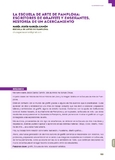Mostrar el registro sencillo del ítem
La Escuela de Arte de Pamplona: escritores de graffiti y enseñantes, historia de un acercamiento
| dc.creator | García Camón, María Jesús | es_ES |
| dc.date.accessioned | 2015-12-23T08:03:05Z | |
| dc.date.available | 2015-12-23T08:03:05Z | |
| dc.date.issued | 2012 | |
| dc.identifier.isbn | 978-84-7681-763-6 | |
| dc.identifier.uri | https://hdl.handle.net/2454/19786 | |
| dc.description.abstract | My name is María Jesús García Camón, although my students call me “Chusa”. I teach Art History and the History of Books and Graphic Images in the School of Arts in Pamplona, northern Spain. I made contact with the world of graffiti because some of my students practiced it. I wanted to learn from them and we jointly defined a working approach that led us to prepare graffiti workshops and exhibitions, some of them elsewhere in Spain. We were able to obtain support from institutions such as the Ateneo Navarro, Pamplona City Council and, naturally, the School of Arts. The works created were exhibited in the Citadel of Pamplona and were pioneers in showing graffiti in a place that had only been used for art exhibitions before. My students, who come from all kinds of academic disciplines, felt freer and more respected in the School of Arts. They could also apply what they had learned in different areas –Drawing, Colour, Design, and Art History– to their urban mural work. Their work is now related to art: illustration, murals, graphic design... A new generation of students who have produced graffiti are starting to work with us, their teachers, to prepare an exhibition in the school. The images will be on display there permanently, as previously happened with the 1999 exhibition; the images continue to decorate the walls of the school at the spot where the students most like to meet. | en |
| dc.description.abstract | Me llamo María Jesús García Camón. Mis alumnos me llaman Chusa. Imparto clases de Historia del Arte e Historia del Libro y la Imagen Gráfica en la Escuela de Arte de Pamplona. Entré en contacto con el mundo del graffiti gracias a alguno de mis alumnos que lo practicaban. Quise aprender de ellos y establecimos una línea de trabajo conjunto que nos llevó a colaborar preparando talleres y exhibiciones de graffiti, alguna de ámbito nacional. Contamos con la ayuda de instituciones como el Ateneo Navarro, el Ayuntamiento de Pamplona y, por supuesto, la Escuela de Arte. Las obras resultantes se expusieron en la Ciudadela de Pamplona, siendo pioneros en mostrar el graffiti en un lugar consagrado a las exposiciones de arte. Mis alumnos, provenientes de otro tipo de enseñanzas, se sintieron en la Escuela de Arte más libres y respetados. Además pudieron aplicar lo aprendido en las distintas materias: Dibujo, Color, Diseño, Historia del Arte… a su obra mural urbana. Hoy, su trabajo tiene relación con el arte: ilustración, muralismo, diseño gráfico… Ahora, una nueva generación de alumnos autores de graffiti comienza a relacionarse con nosotros, sus profesores, preparando una exhibición en el centro. Las imágenes resultantes se mostrarán en la Escuela, de forma permanente, como ya ocurre con las de la exhibición de 1999, que continúan decorando los muros de la Escuela en el lugar favorito de encuentro entre los estudiantes. | es_ES |
| dc.format.mimetype | application/pdf | en |
| dc.language.iso | spa | en |
| dc.publisher | Pamiela - Edarte | es_ES |
| dc.relation.ispartof | Edarte, Grupo de investigación (ed.) (2013). Investigar con jóvenes: ¿Qué sabemos de los jóvenes como productores de cultura visual? Pamplona: Pamiela – Edarte (UPNA/NUP) | es_ES |
| dc.rights | Creative Commons: Reconocimiento-NoComercial-SinObraDerivada | es_ES |
| dc.rights.uri | http://creativecommons.org/licenses/by-nc-nd/3.0/es/ | |
| dc.subject | Graffiti | en |
| dc.subject | School of Arts | en |
| dc.subject | Art education | en |
| dc.subject | Graffiti | es_ES |
| dc.subject | Escuela de Arte de Pamplona | es_ES |
| dc.subject | Educación artística | es_ES |
| dc.title | La Escuela de Arte de Pamplona: escritores de graffiti y enseñantes, historia de un acercamiento | es_ES |
| dc.type | info:eu-repo/semantics/conferenceObject | en |
| dc.type | Contribución a congreso / Biltzarrerako ekarpena | es |
| dc.rights.accessRights | info:eu-repo/semantics/openAccess | en |
| dc.rights.accessRights | Acceso abierto / Sarbide irekia | es |



